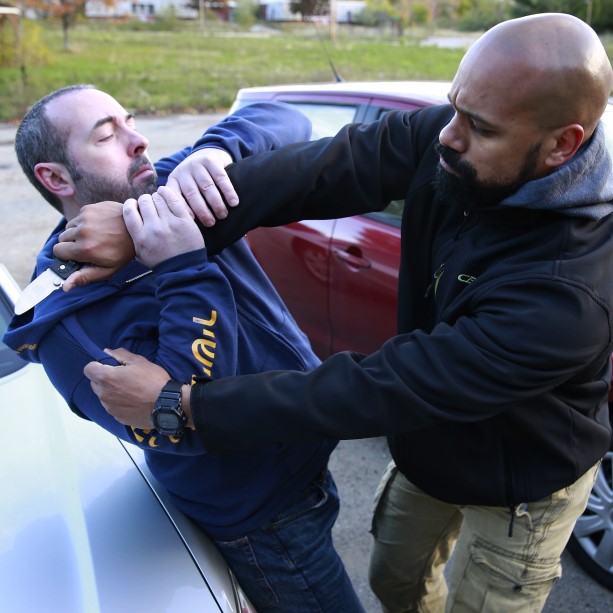Krav Maga Classes & Training
Krav Maga Classes in Boston
Krav Maga, meaning "Contact Combat" in Hebrew was originally a distinct system of self-defense and hand-to-hand fighting developed by Imi Lichtenfeld (26th May 1910 - 9th January 1998) and other instructors within the Haganah - the underground Jewish resistance and defense force active in what was then Palestine, in the 1930's and 1940's. . The goal of his system was to train, a soldier with no previous martial arts or self-defense training, to be able to defend themselves, against a variety of armed and unarmed attacks in the shortest possible time. He was developing his system against the backdrop of Israeli Independence, as the underground resistance movements (e.g. the Haganah - meaning "Defense" in Hebrew) were about to be amalgamated into the fledgling IDF (Israeli Defense Forces). The fact that the Jewish population of Palestine, would be attacked the moment they declared themselves an Independent Jewish State, not just be their domestic Arab neighbors, but by the armies of the Arab countries that surrounded their territory e.g. Lebanon, Egypt, Syria and Jordan, would mean that Israeli Soldiers would not have much time to train before they had to put their fighting skills to the test in real-life encounters.
To do this, Lichtenfeld designed his system around the body's natural reflexive responses when attacked e.g. people naturally flinch when they catch movements coming towards them, a person's hands will automatically come up to pull an attacker's hands or arm(s) away if they are being choked or strangled, the hips will be pulled back, and the arms will go forward if an upwards attack to the groin/stomach area is detected etc. Rather than trying to change the way a person naturally responds and try to replace these natural reactions with "trained" movements, Lichtenfeld built upon them, to create a system of self-defense that was based on the way a person will respond when attacked, rather than how they may like to think they'll respond. He also looked to re-use techniques, so that a defense against a rear strangle, was similar to a defense against a knife threat to the front of the throat, when the attacker is standing behind their target e.g. in a hostage type situation. His original system consisted of something around 28 techniques, and was designed to be used by an infantry soldier carrying a pack on his back - this is why his original system contained only forward movement (to have sideways movement may have compromised the balance of the soldier).
Imi also drew on his experiences as a young man, fighting against Fascist street gangs, in his native Slovakia. In these situations he had both witnessed the way untrained people responded to various attacks, and come to understand what real-life violence actually looked like e.g. multiple assailants who were probably armed. From this he understood that it was not possible to spend an extended period of time dealing with one attacker; each one needed to be dealt with and dispatched as quickly as possible, which meant using strikes to soft and vulnerable targets such as the eyes and groin.
Imi left the IDF in 1964 and started developing his Krav Maga system for civilians, later establishing the non-profit IKMA (Israeli Krav Maga Association) in 1988. Of course Krav Maga didn't stop evolving, and the IDF (Israeli Defense Forces) didn't stop looking at other systems of close combat, and other instructor's approaches to self-defense and fighting. One of the most influential instructors to affect the IDF's approach to hand-to-hand fighting was Doctor Dennis Hanover (founder of DSJJ - Dennis Survival Ju-Jitsu - which is often referred to as Hisardut, meaning "Survival" in Hebrew). Dennis Hanover's background was in the traditional martial arts and his approach emphasized the need for dynamic and full contact training. He also demonstrated how traditional systems such as Judo and Karate could be adapted for military use.
Krav Maga continued to develop in the civilian sector, with many of Imi's top belts going on to form their own associations and develop and evolve his approach to self-defense and close combat and/or mix it with their own backgrounds in other martial arts and systems. The way in which Krav Maga has evolved and developed into a number of distinct systems means that "Krav Maga" is more of a generic term that refers to a number of systems which share a common approach and methodology rather than to a distinct system of self-defense. The IDF itself uses Krav Maga in this manner, as an umbrella term, for what its hand-to-hand combat instructors teach. To read more about the common principles and concepts that Krav Maga systems are founded upon, and those which make the Krav Maga Yashir system unique. If you want to take a beginner class to experience what authentic Krav Maga is please use the button below.
Book Class

